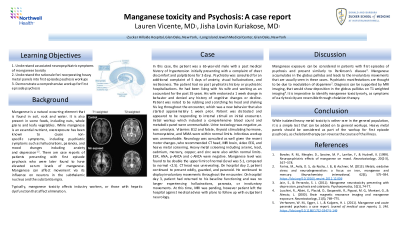Neurocognitive Disorders, Delirium, and Neuropsychiatry
Session: Poster Session
(094) Manganese Toxicity and Psychosis: A Case Report

Trainee Involvement: Yes

Lauren Vicente, MD
Resident Psychiatrist
Zucker Hillside Hospital at Northwell/Hofstra
Staten Island, New York, United States.jpg)
Jisha Lovin Kuriakose, MD
Attending Psychiatrist, Consultation Liaison Psychiatry
Long Island Jewish Medical Center- Northwell Health
New Hyde Park, New York, United States
Presenting Author(s)
Co-Author(s)
Background: Manganese is a natural occurring element that is found in soil, rock and water. It is also present in some foods, including nuts, whole grains and leafy vegetables. While manganese is an essential nutrient, overexposure has been known to cause non-specific symptoms, including psychiatric symptoms such as hallucinations, paranoia, and mood changes including anxiety and depression (Verhoeven et.al., 2011; Bowler et.al., 1999). There are case reports of patients presenting with first episode psychosis who were later found to have elevated serum levels of manganese. Case: A 65-year-old male with a medical history of hypertension presented to the Emergency Department with chest discomfort and palpitations for 3 days. Consultation Liaison Psychiatry was consulted for recent onset change in behaviors, anxiety, visual hallucinations, and restlessness. On assessment, patient was noted to be scratching his head and with involuntary leg movements (high amplitude, low frequency) throughout the encounter. He was distracted and appeared to be responding to internal stimuli. Comprehensive laboratory studies were unremarkable. Heavy metal screening showed manganese level to be twice the upper limit of normal (level was 5.1, compared to a normal < 2.5). Further brain imaging and psychiatric treatment was recommended but the patient left against medical advice (AMA). Discussion: Manganese exposure can be considered in patients with first episodes of psychosis and present similarly to Parkinson’s disease (Jain et.al., 2011). Manganese accumulates in the globus pallidus and leads to the involuntary movements that are usually seen in these cases. Psychiatric manifestations are thought to be due to modulation of dopamine (Farina et.al., 2013). Diagnosis can be supported by MRI imaging, that would show deposition in the globus pallidus on T1 weighted imaging (Lucchini et.al., 2000). It is imperative to identify manganese toxicity early, as symptoms of early toxicity are reversible through chelation therapy. Conclusion: Heavy metal panels should be considered as part of the workup for first episode psychosis, as chelation therapy can reverse the course of the illness. References Bowler, R. M., Mergler, D., Sassine, M. P., Larribe, F., & Hudnell, K. (1999). Neuropsychiatric effects of manganese on mood. Neurotoxicology, 20(2-3), 367–378. Farina, M., Avila, D. S., da Rocha, J. B., & Aschner, M. (2013). Metals, oxidative stress and neurodegeneration: a focus on iron, manganese and mercury. Neurochemistry international, 62(5), 575–594. https://doi.org/10.1016/j.neuint.2012.12.006 Jain, S., & Ferrando, S. J. (2011). Manganese neurotoxicity presenting with depression, psychosis and catatonia. Psychosomatics, 52(1), 74-77. Lucchini, R., Albini, E., Placidi, D., Gasparotti, R., Pigozzi, M. G., Montani, G., & Alessio, L. (2000). Brain magnetic resonance imaging and manganese exposure. Neurotoxicology, 21(5), 769–775. Verhoeven, W. M., Egger, J. I., & Kuijpers, H. J. (2011). Manganese and acute paranoid psychosis: a case report. Journal of medical case reports, 5, 146. https://doi.org/10.1186/1752-1947-5-146

